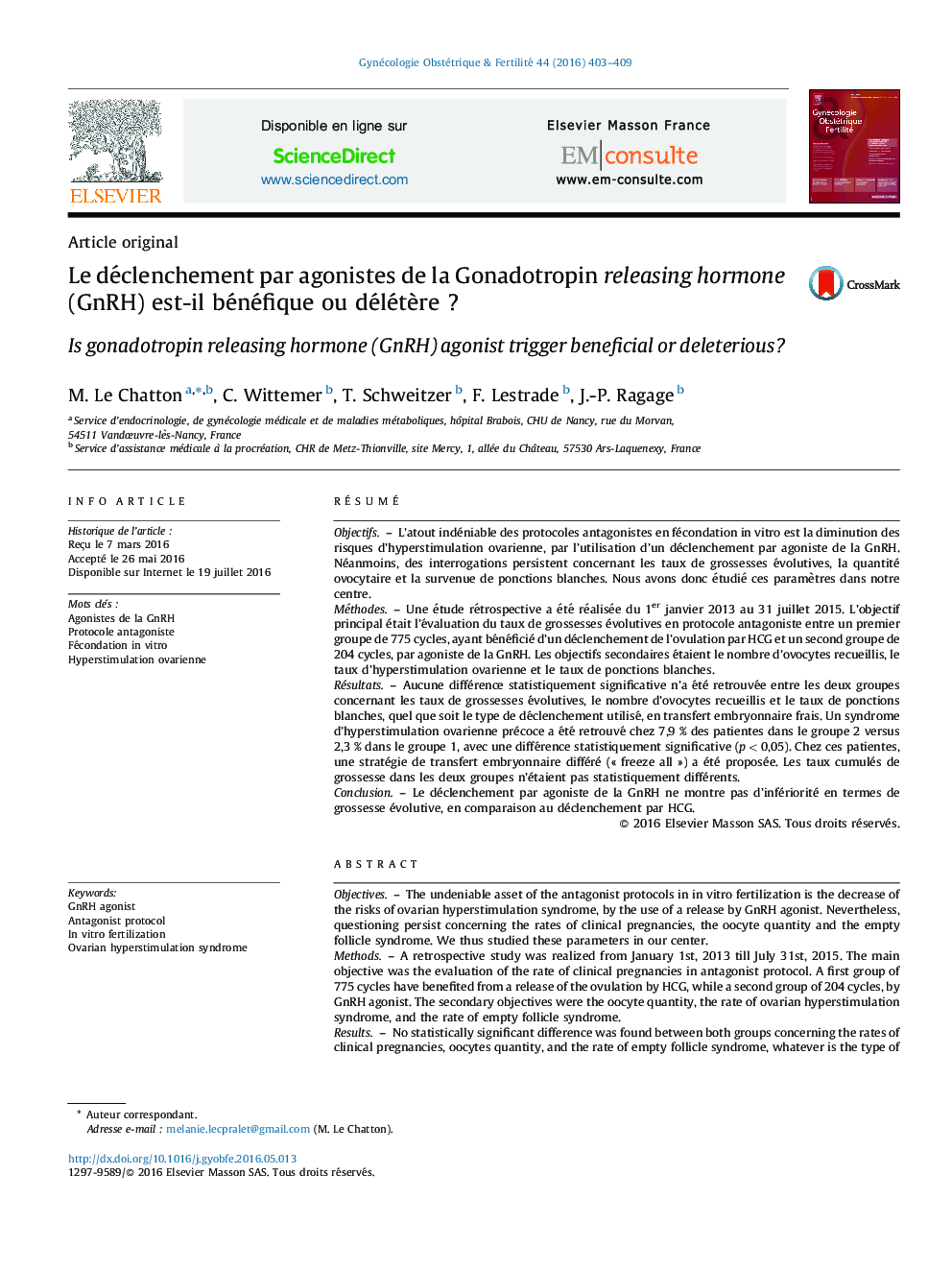| Article ID | Journal | Published Year | Pages | File Type |
|---|---|---|---|---|
| 3948606 | Gynécologie Obstétrique & Fertilité | 2016 | 7 Pages |
RésuméObjectifsL’atout indéniable des protocoles antagonistes en fécondation in vitro est la diminution des risques d’hyperstimulation ovarienne, par l’utilisation d’un déclenchement par agoniste de la GnRH. Néanmoins, des interrogations persistent concernant les taux de grossesses évolutives, la quantité ovocytaire et la survenue de ponctions blanches. Nous avons donc étudié ces paramètres dans notre centre.MéthodesUne étude rétrospective a été réalisée du 1er janvier 2013 au 31 juillet 2015. L’objectif principal était l’évaluation du taux de grossesses évolutives en protocole antagoniste entre un premier groupe de 775 cycles, ayant bénéficié d’un déclenchement de l’ovulation par HCG et un second groupe de 204 cycles, par agoniste de la GnRH. Les objectifs secondaires étaient le nombre d’ovocytes recueillis, le taux d’hyperstimulation ovarienne et le taux de ponctions blanches.RésultatsAucune différence statistiquement significative n’a été retrouvée entre les deux groupes concernant les taux de grossesses évolutives, le nombre d’ovocytes recueillis et le taux de ponctions blanches, quel que soit le type de déclenchement utilisé, en transfert embryonnaire frais. Un syndrome d’hyperstimulation ovarienne précoce a été retrouvé chez 7,9 % des patientes dans le groupe 2 versus 2,3 % dans le groupe 1, avec une différence statistiquement significative (p < 0,05). Chez ces patientes, une stratégie de transfert embryonnaire différé (« freeze all ») a été proposée. Les taux cumulés de grossesse dans les deux groupes n’étaient pas statistiquement différents.ConclusionLe déclenchement par agoniste de la GnRH ne montre pas d’infériorité en termes de grossesse évolutive, en comparaison au déclenchement par HCG.
ObjectivesThe undeniable asset of the antagonist protocols in in vitro fertilization is the decrease of the risks of ovarian hyperstimulation syndrome, by the use of a release by GnRH agonist. Nevertheless, questioning persist concerning the rates of clinical pregnancies, the oocyte quantity and the empty follicle syndrome. We thus studied these parameters in our center.MethodsA retrospective study was realized from January 1st, 2013 till July 31st, 2015. The main objective was the evaluation of the rate of clinical pregnancies in antagonist protocol. A first group of 775 cycles have benefited from a release of the ovulation by HCG, while a second group of 204 cycles, by GnRH agonist. The secondary objectives were the oocyte quantity, the rate of ovarian hyperstimulation syndrome, and the rate of empty follicle syndrome.ResultsNo statistically significant difference was found between both groups concerning the rates of clinical pregnancies, oocytes quantity, and the rate of empty follicle syndrome, whatever is the type of used release, in fresh embryo transfer. A syndrome of premature ovarian hyperstimulation syndrome was found at 7.9 % of the patients in the group 2 versus 2.3 % in the group 1, with a statistically significant difference (P < 0.05). At these patients, a strategy of frozen embryo transfer (“freeze all”) was proposed. The accumulated rates by pregnancy in both groups were not statistically different.ConclusionThe release by GnRH agonist does not show inferiority in terms of clinical pregnancy, in comparison to HCG.
